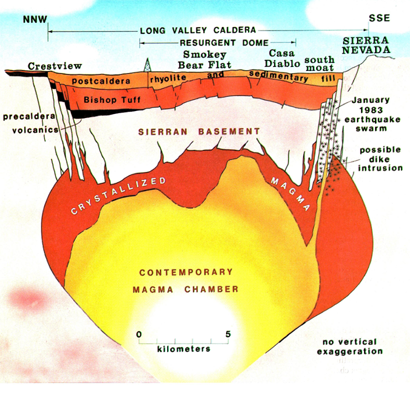

Caption:
FIGURE 7. Cross Section through Long Valley Caldera and
Its Inferred Subjacent Magma Chamber.
Long Valley Calcfera was produced by eruption of Bishop
Tuff 730,000 years ago, which fills the caldera above the
subsided Sierran basement block. Partial emptying of the
upper part of the chamber during these eruptions paused
collapse of the roof of the chamber and sinking of the Sienan
block about 2000 m into the magma below. Subsequent
renewed magma pressure caused arching of the caldera
floor to form the resurgent dome about 700,00 years ago.
Since then the magma chamber has been cooling and crystallizing
from the walls inward (red), gradually reducing the
size of the partially molten chamber (yellow-orange). Recent
(1979-1985) renewed rise of the resurgent dome (0.5 m) and
surrounding earthquake activity indicates renewed filling of
the chamber with magma from depth and possibly injection
of a dike along the caldera ring fracture below the south
moat. The shallower cupola (hump) of magma on the right,
based on Sanders's seismic attenuation studies, appears to
be the center of the current uplift. The heavier lines at the
upper left and lower right margins of the contemporary
magma chamber mark the location of seismic phase transitions
detected by Hill, Leutgert, and colleagues. (Cross section
prepared by Roy Bailey and Dave Hill, U.S. Geological
Survey, Apr. 30, 1985. Publication by permission of the
American Geophysical Union.)
Context:
Early in 1980 Alan Ryall, taking note of the 1978 magnitude-5.7
quake and subsequent swarms, predicted that a large quake could
be expected in the region within the foreseeable future. In May
of 1980 four quakes of magnitude 6 occurred within hours,
followed by a magnitude 5.9 in September 1981, and three
magnitude-5.0-5.2 quakes in January 1983 within a swarm of
thousands of smaller quakes. Repeated geodetic surveys of the
region have shown that the resurgent dome has been stretching
laterally and has been lifted vertically approximately 50 cm
since 1979. Jim Savage and Malcolm Clark of the Geological Survey
have mathematically modeled the swelling as due to expansion of a
spherical chamber at a depth of l0-11 km beneath the resurgent
dome by the injection of 0.15 cubic km of magma (see Figure 7).
Abstract:
Seismology has burgeoned into a modern science -- force-fed by federal funding to advance
technology for detecting underground nuclear explosions and predicting earthquakes, and by
industry to improve tools for gas and oil exploration. Computers, seismic instrument
systems, telemetry, and data reduction have played key roles in this growth.
Source:
M. R. Raugh, "Modeling California Earthquakes and Earth Structures",
Communications of the ACM, Volume 28, Number 11, Pages 1130-1150 (November 1985).
Acknowledgements:
Document contributed by Xiang Rong Mei and assembled by Colin Rego,
Northeastern University, 3/2004. The text in this article had been
obtained by OCR and had errors which we have attempted to correct
in the excerpts here (RPF).